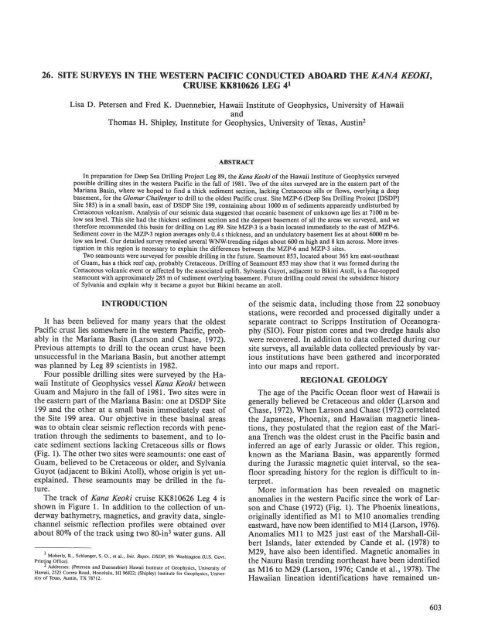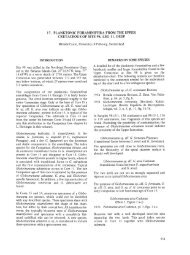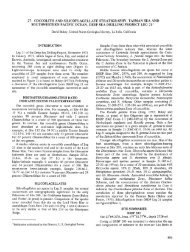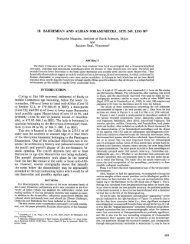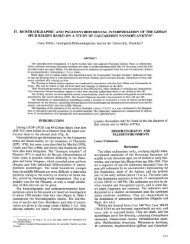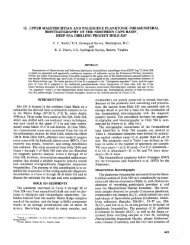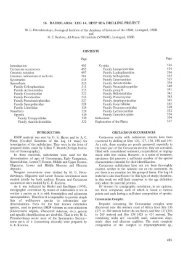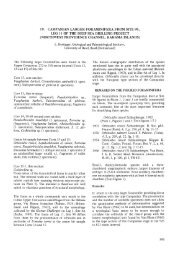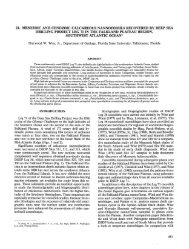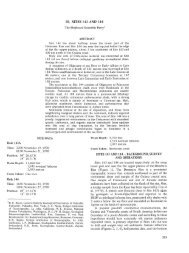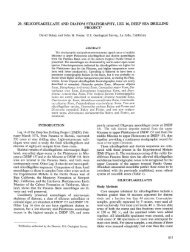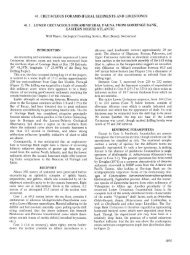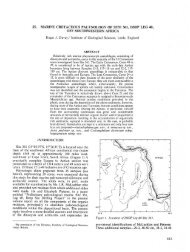You also want an ePaper? Increase the reach of your titles
YUMPU automatically turns print PDFs into web optimized ePapers that Google loves.
26. SITE SURVEYS IN THE WESTERN PACIFIC CONDUCTED ABOARD THE KANA KEOKI,<br />
CRUISE KK810626 LEG 4 1<br />
Lisa D. Petersen and Fred K. Duennebier, Hawaii Institute of Geophysics, University of Hawaii<br />
and<br />
Thomas H. Shipley, Institute for Geophysics, University of Texas, Austin 2<br />
ABSTRACT<br />
In preparation for <strong>Deep</strong> <strong>Sea</strong> <strong>Drilling</strong> <strong>Project</strong> Leg 89, the Katia Keoki of the Hawaii Institute of Geophysics surveyed<br />
possible drilling sites in the western Pacific in the fall of 1981. Two of the sites surveyed are in the eastern part of the<br />
Mariana Basin, where we hoped to find a thick sediment section, lacking Cretaceous sills or flows, overlying a deep<br />
basement, for the Glomar Challenger to drill to the oldest Pacific crust. Site MZP-6 (<strong>Deep</strong> <strong>Sea</strong> <strong>Drilling</strong> <strong>Project</strong> [DSDP]<br />
Site 585) is in a small basin, east of DSDP Site 199, containing about 1000 m of sediments apparently undisturbed by<br />
Cretaceous volcanism. Analysis of our seismic data suggested that oceanic basement of unknown age lies at 7100 m below<br />
sea level. This site had the thickest sediment section and the deepest basement of all the areas we surveyed, and we<br />
therefore recommended this basin for drilling on Leg 89. Site MZP-3 is a basin located immediately to the east of MZP-6.<br />
Sediment cover in the MZP-3 region averages only 0.4 s thickness, and an undulatory basement lies at about 6000 m below<br />
sea level. Our detailed survey revealed several WNW-trending ridges about 600 m high and 8 km across. More investigation<br />
in this region is necessary to explain the differences between the MZP-6 and MZP-3 sites.<br />
Two seamounts were surveyed for possible drilling in the future. <strong>Sea</strong>mount 853, located about 365 km east-southeast<br />
of Guam, has a thick reef cap, probably Cretaceous. <strong>Drilling</strong> of <strong>Sea</strong>mount 853 may show that it was formed during the<br />
Cretaceous volcanic event or affected by the associated uplift. Sylvania Guyot, adjacent to Bikini Atoll, is a flat-topped<br />
seamount with approximately 285 m of sediment overlying basement. Future drilling could reveal the subsidence history<br />
of Sylvania and explain why it became a guyot but Bikini became an atoll.<br />
INTRODUCTION<br />
It has been believed for many years that the oldest<br />
Pacific crust lies somewhere in the western Pacific, probably<br />
in the Mariana Basin (Larson and Chase, 1972).<br />
Previous attempts to drill to the ocean crust have been<br />
unsuccessful in the Mariana Basin, but another attempt<br />
was planned by Leg 89 scientists in 1982.<br />
Four possible drilling sites were surveyed by the Hawaii<br />
Institute of Geophysics vessel Kana Keoki between<br />
Guam and Majuro in the fall of 1981. Two sites were in<br />
the eastern part of the Mariana Basin: one at DSDP Site<br />
199 and the other at a small basin immediately east of<br />
the Site 199 area. Our objective in these basinal areas<br />
was to obtain clear seismic reflection records with penetration<br />
through the sediments to basement, and to locate<br />
sediment sections lacking Cretaceous sills or flows<br />
(Fig. 1). The other two sites were seamounts: one east of<br />
Guam, believed to be Cretaceous or older, and Sylvania<br />
Guyot (adjacent to Bikini Atoll), whose origin is yet unexplained.<br />
These seamounts may be drilled in the future.<br />
The track of Kana Keoki cruise KK810626 Leg 4 is<br />
shown in Figure 1. In addition to the collection of underway<br />
bathymetry, magnetics, and gravity data, singlechannel<br />
seismic reflection profiles were obtained over<br />
about 80% of the track using two 80-in 3 water guns. All<br />
Moberly, R., Schlanger, S. O., et al., Init. Repts. DSDP, 89: Washington (U.S. Govt.<br />
Printing Office).<br />
2 Addresses: (Petersen and Duennebier) Hawaii Institute of Geophysics, University of<br />
Hawaii, 2525 Correa Road, Honolulu, HI 96822; (Shipley) Institute for Geophysics, University<br />
of Texas, Austin, TX 78712.<br />
of the seismic data, including those from 22 sonobuoy<br />
stations, were recorded and processed digitally under a<br />
separate contract to Scripps Institution of Oceanography<br />
(SIO). Four piston cores and two dredge hauls also<br />
were recovered. In addition to data collected during our<br />
site surveys, all available data collected previously by various<br />
institutions have been gathered and incorporated<br />
into our maps and report.<br />
REGIONAL GEOLOGY<br />
The age of the Pacific Ocean floor west of Hawaii is<br />
generally believed be Cretaceous and older (Larson and<br />
Chase, 1972). When Larson and Chase (1972) correlated<br />
the Japanese, Phoenix, and Hawaiian magnetic lineations,<br />
they postulated that the region east of the Mariana<br />
Trench was the oldest crust in the Pacific basin and<br />
inferred an age of early Jurassic or older. This region,<br />
known as the Mariana Basin, was apparently formed<br />
during the Jurassic magnetic quiet interval, so the seafloor<br />
spreading history for the region is difficult to interpret.<br />
More information has been revealed on magnetic<br />
anomalies in the western Pacific since the work of Larson<br />
and Chase (1972) (Fig. 1). The Phoenix lineations,<br />
originally identified as Ml to M10 anomalies trending<br />
eastward, have now been identified to M14 (Larson, 1976).<br />
Anomalies Mil to M25 just east of the Marshall-Gilbert<br />
Islands, later extended by Cande et al. (1978) to<br />
M29, have also been identified. Magnetic anomalies in<br />
the Nauru Basin trending northeast have been identified<br />
as M16 to M29 (Larson, 1976; Cande et al., 1978). The<br />
Hawaiian lineation identifications have remained un-<br />
603
L. D. PETERSEN, F. K. DUENNEBIER, T. H. SHIPLEY<br />
140° 150 160° 170° 180° 150° 160° 170°E<br />
Figure 1. A. Kana Keoki cruise KK810626 Leg 4 ship track (fine line) with magnetic lineations that surround the Mariana Basin. B. Sketch map of<br />
the western Pacific showing Kana Keoki ship track (thin solid line), M-25 magnetic anomalies (Cande et al., 1978) (thick solid line), and selected<br />
DSDP sites (dots with site number). Site surveys shown as numbered boxes: (1) <strong>Sea</strong>mount 853, (2) MZP-6, (3) MZP-3, (4) Sylvania Guyot. Figure<br />
after Shipley et al. (1983).<br />
changed, except that the Jurassic anomalies have been<br />
extended back to M29 (Cande et al., 1978). The Japanese<br />
lineations are also identified to M29, and Hussong<br />
and Fryer (1982) mapped northeast-trending Anomalies<br />
M23 to M25 northeast of Guam. With this information<br />
on magnetic anomalies in the western Pacific came many<br />
more interpretations of the tectonic evolution of the Pacific<br />
Plate, but still no more conclusions about the Mariana<br />
Basin, other than that it should be Jurassic Pacific<br />
crust. We refer the reader to the following papers (in<br />
chronological order) for Pacific evolutionary models:<br />
Hayes and Pitman, 1970; Larson and Pitman, 1972; Larson<br />
and Chase, 1972; Moberly and Larson, 1975; Lancelot<br />
and Larson, 1975; Winterer, 1976; Larson, 1976;<br />
Jackson and Schlanger, 1976; Hilde, et al., 1977; Tamaki<br />
et al., 1979; Orwig and Kroenke, 1980; Schlanger and<br />
Premoli Silva, 1981.<br />
Before DSDP Leg 89, three DSDP holes in the Mariana<br />
Basin were drilled in hope of sampling Jurassic crust:<br />
Sites 59 and 61 southeast of Guam and Site 199 east of<br />
Guam at 156°E longitude. <strong>Drilling</strong> at Site 59 recovered<br />
Eocene and Paleocene clay and bottomed out at 1135 m<br />
in Cretaceous cherty and ashy clay (Heezen, Fischer, et<br />
al., 1971). Coring at Site 61 sampled clays and Upper<br />
Cretaceous cristobalitic mudstones associated with tuff,<br />
and ended in amygdaloidal basalt at 96 m (Winterer,<br />
Riedel, et al., 1971). At Site 199, 456.5 m of Eocene-<br />
Miocene turbidites, Upper Cretaceous-Paleocene limestones,<br />
and lower Campanian tuff were recovered (Heezen,<br />
MacGregor, et al., 1973). <strong>Drilling</strong> at all three holes<br />
failed to reach basement.<br />
In 1978, the Glomar Challenger visited the Nauru Basin<br />
southeast of the Mariana Basin. <strong>Drilling</strong> at Site 462<br />
(Larson, Schlanger, et al., 1981) revealed a thick sequence<br />
of Cretaceous intrusive and extrusive basalts under Ter-<br />
604<br />
tiary sediments. The cause of the volcanism is open to<br />
speculation, but interpretation of the volcanic complex<br />
and correlations with other structures in the Pacific lead<br />
to the conclusion that the Cretaceous volcanic event was<br />
widespread, possibly worldwide (Larson, Schlanger, et<br />
al., 1981; Schlanger and Premoli Silva, 1981). The chances<br />
are good that at least parts of the Mariana Basin were<br />
affected by the Cretaceous volcanism and may have sill<br />
complexes beneath upper Mesozoic as well as Tertiary<br />
sediments.<br />
<strong>Sea</strong>mount 853<br />
SITE OBJECTIVES AND GEOLOGY<br />
The first site survey conducted aboard the Kana Keoki<br />
on cruise KK810626 Leg 4 was "<strong>Sea</strong>mount 853" (the<br />
name originates from its depth of 853 fathoms on SIO<br />
Bathymetry Map 2203N; Scripps Institute of Oceanography,<br />
1968), located approximately 365 km east-southeast<br />
of Guam (Fig. 1). We approached the site from the<br />
west, passing over DSDP Site 61 before entering the<br />
area. The survey lasted about 32 hours: one airgun-sonobuoy<br />
precision echo recording (ASPER) record was<br />
taken, a dredge haul was recovered, and single-channel<br />
seismic reflection data were taken continuously on four<br />
graphic recorders (low-frequency, 25-50 Hz; mid-frequency,<br />
65-130 Hz; high-frequency 130-260 Hz; and mixedfrequency,<br />
25-50/130-260 Hz) and on the SIO digital<br />
system (the source was one 80-in 3 water gun). Gravity<br />
and magnetic data were continuously recorded while the<br />
vessel was underway. Geophysical data profiled along<br />
the ship's track are shown in Figure 2.<br />
Data from 11 cruises (including this survey) were used<br />
to produce the bathymetric contour map for <strong>Sea</strong>mount<br />
853 and other seamounts nearby (Fig. 3). <strong>Sea</strong>mount 853
800 1200 1600 2000 0<br />
922<br />
Time<br />
400 800 1 200 1600 2000 0<br />
923<br />
SITE SURVEYS IN THE WESTERN PACIFIC<br />
Figure 2. Underway geophysical data profiled along track of Kana Keoki cruise KK810626 Leg 4 over<br />
<strong>Sea</strong>mount 853.<br />
(at the center of Fig. 3) rises 3800 m above the seafloor<br />
and has a convex surface with a minimum depth of about<br />
1600 m below sea level. An east-west-trending ridge about<br />
4 km across and from 150 to 450 m high crosses the center<br />
of the seamount at about 12°25'N (Figs. 2, 3, 4).<br />
The seismic reflection profile (Fig. 4) along a NW-SE<br />
track across <strong>Sea</strong>mount 853 is from the high-frequency<br />
(130-260 Hz) recorder. The pelagic ooze layer at the center<br />
of the seamount is 200 ms thick and overlies the reef<br />
cap at 2.4 s. Fringing reef is visible at the right. The<br />
ridge was crossed at the western edge, and is only 150 m<br />
high in this profile. The ridge may be an erosional remnant<br />
of a subaerial volcano that existed when the seamount<br />
was above sea level. Dredge RD-65 on the southeast<br />
slope of <strong>Sea</strong>mount 853 was successful in recovering<br />
samples of basalt, andesite(?), limestone, beachrock, and<br />
chert with manganese crusts. One sample was determined<br />
to be Cretaceous (C. Mato, personal communication,<br />
1981).<br />
The free-air gravity map (Fig. 5) was constructed using<br />
data from a total of six cruises. There is a maximum<br />
of about +170 mgal over <strong>Sea</strong>mount 853, and in general<br />
the gravity contours follow the bathymetric contours.<br />
This positive gravity anomaly indicates that the seamount<br />
is not compensated (at least not locally).<br />
Eleven cruises (including ours) passed over this site collecting<br />
residual-magnetism data. After correction for diurnal<br />
variations and reduction of the data to one International<br />
Geomagnetic Reference Field (IGRF) level<br />
(1979) (International Association of Geophysics and Aeronomy,<br />
1976), only four cruises (DSDP61, ERDC09,<br />
KK81062604, VI907) had usable data, so we have only a<br />
fair amount of confidence in the magnetic contour map<br />
(Fig. 6). There appears to be a maximum of about 0<br />
gammas over the center of <strong>Sea</strong>mount 853, and a low of<br />
- 300 gammas on the north side, and another low of<br />
about - 400 gammas on the southeast flank of the seamount.<br />
No attempt has been made to model the magnetic<br />
signature.<br />
Before reaching the <strong>Sea</strong>mount 853 region, our ship<br />
passed over DSDP Site 61, located about 100 km southwest<br />
of <strong>Sea</strong>mount 853 (Fig. 1). <strong>Drilling</strong> recovery at this<br />
site includes Tertiary clays and Upper Cretaceous cristobalitic<br />
mudstones with tuff (Winterer, Riedel, et al.,<br />
1971). The hole bottomed out in basalt at 96 m; this basalt<br />
may be related to that of the nearby seamounts (Kroenke<br />
and Moberly, 1971).<br />
On the basis of its age, depth below sea level, and<br />
thick reef cap, we suspect that <strong>Sea</strong>mount 853 may have<br />
been formed by the Cretaceous volcanism, or at least affected<br />
by the associated uplift. <strong>Drilling</strong> of <strong>Sea</strong>mount<br />
853 could reveal subsidence history, and may show that<br />
Cretaceous volcanism extended as far west as the present-day<br />
Mariana Trench.<br />
MZP-6 (DSDP Site 585)<br />
Our MZP-6 survey in the eastern part of the Mariana<br />
Basin includes DSDP Site 199, located at 13°3O.8'N,<br />
156° 10.3'E (Fig. 1). The Glomar Challenger visited this<br />
spot in 1971 (Heezen, MacGregor, et al., 1973) and drilled<br />
456.5 m of Tertiary and Upper Cretaceous sediments<br />
(basement was not reached). Seismic reflection records<br />
605
L. D. PETERSEN, F. K. DUENNEBIER, T. H. SHIPLEY<br />
148°E<br />
Figure 3. Bathymetry of <strong>Sea</strong>mount 853 (at center) and neighboring seamounts. Multiply values by 100<br />
to get depth in ms; contour interval 200 ms. Ship tracks are shown with fine lines and identified by<br />
abbreviated cruise names and numbers. Star shows location of dredge RD-65 on side of <strong>Sea</strong>mount<br />
853.<br />
obtained by the Challenger were poor. Our objective during<br />
this site survey was to produce good reflection records<br />
and to "see" through sediments and suspected sills<br />
to basement.<br />
The Kana Keoki entered the area from the west, surveyed<br />
Site 199 in a bow-tie pattern (crossing the site<br />
three times), and departed to the east (Fig. 1). Gravity<br />
and magnetic readings were taken continuously, as were<br />
seismic reflection data on the four graphic recorders and<br />
the SIO digital system (two 80-in 3 water guns were used<br />
as the source), and an ASPER record was made each<br />
time the ship passed over Site 199. Underway geophysical<br />
data are profiled along the ship's track in Figure 7.<br />
No coring or dredging was attempted.<br />
The bathymetry map of the MZP-6 area was constructed<br />
with data from a total of six cruises (Fig. 8). Across<br />
the center of the survey area is a flat-floored basin, about<br />
6100 m below sea level, which rarely shows more than<br />
606<br />
30 m of relief. One pinnacle 1050 m high is located<br />
about 15 km southwest of Site 199. A cluster of seamounts<br />
rising about 4600 m above the seafloor (to 1500<br />
m below sea level) to the north of the flat basin is shown<br />
on the SIO Bathymetry Map 2103N in slightly different<br />
form (Scripps Institution of Oceanography, 1968). Ita<br />
Maitai Guyot (drilled on DSDP Leg 20) also rises 4600<br />
m above the seafloor, and is shown in the lower righthand<br />
area of Figure 8. Ita Maitai is believed to have<br />
been affected by the uplift associated with the Cretaceous<br />
volcanism (Schlanger and Premoli Silva, 1981);<br />
the other seamounts in this region may also have been<br />
affected.<br />
A sediment isopach map (Fig. 9) was produced primarily<br />
from KK810626 Leg 4 reflection records; KK810626 Leg<br />
2 airgun records, taken north of Ita Maitai Guyot, were<br />
also used. In general, there are no sediments on the seamount<br />
slopes, and the thickest sediment section occurs
2.0<br />
•B 2.5<br />
NW<br />
3.0<br />
3.2 L<br />
"I<br />
ftààttU''<br />
-31.1 km-<br />
SITE SURVEYS IN THE WESTERN PACIFIC<br />
r \<br />
'.fi<br />
| , •<br />
s IP •<br />
SE<br />
1500<br />
1600<br />
1700<br />
1800<br />
ε<br />
•σ<br />
£<br />
1900 |<br />
o<br />
o<br />
c<br />
2000 g T3<br />
Figure 4. Seismic reflection profile along a NW-SE track across <strong>Sea</strong>mount 853, from the high-frequency (130-260 Hz) recorder.<br />
The pelagic ooze layer at the center of the seamount is about 200 ms thick. The reflector at 2.4 s is probably the<br />
reef cap. Fringing reef is at right. Dredge RD-65 was taken from the southeast slope of <strong>Sea</strong>mount 853 near the right<br />
edge of this profile.<br />
in the basin. This contour map indicates that the pinnacle<br />
southwest of Site 199 could be a linear ridge instead<br />
of an isolated seamount. Reflection records from our<br />
track along 13°3O'N latitude east of Site 199 show the<br />
sediments to be about 1100 ms thick near the center of<br />
the basin. Figure 10 shows the digitally processed form<br />
of seismic reflection data recorded by SIO, together with<br />
lithologic interpretation of the reflectors by Shipley et<br />
al. (1983). These investigators determined that the upper<br />
640 ms of section has a velocity of 1830 m/s, representing<br />
590 m of turbidites and pelagic deposits below<br />
the CCD (carbonate compensation depth). Below this<br />
was 260 m of sediments with a velocity of 2010 m/s.<br />
The interval from 9.0 to 9.1 s was believed to be 150 m<br />
of limestones with a velocity of 3000 m/s, deposited<br />
above the CCD. Basaltic basement, then, appeared to<br />
be about 7100 m below sea level.<br />
A free-air gravity map was compiled with data from<br />
five cruises, including KK810626 Leg 4 (Fig. 11). Positive<br />
anomalies are located at the seamounts. There is a<br />
negative anomaly of - 60 mgal over the thick sediments<br />
east of Site 199.<br />
2100<br />
2200<br />
2300<br />
Φ<br />
I<br />
Residual magnetism values collected in the MZP-6 area<br />
were too sparse to allow contouring or interpretation.<br />
We recommended to Leg 89 scientists that the basin<br />
east of Site 199 would be the best location for drilling to<br />
Jurassic(?) Pacific crust. The 1000-m-thick sediment section<br />
appeared to lack any sills or flows, and oceanic<br />
basement appeared to lie at about 7100 m. Although the<br />
surrounding seamounts may be Cretaceous, we believed<br />
that the basin might have been affected to some extent<br />
by uplift, but did not contain Cretaceous sills or flows.<br />
<strong>Drilling</strong> at Site 585 by the Glomar Challenger on Leg 89<br />
ended in upper Aptian to middle Albian sediments at a<br />
depth of 893 m. Basement of unknown age possibly lies<br />
deeper than our site survey data predicted.<br />
MZP-3<br />
The third site survey was in a small basin east of the<br />
Mariana Basin between 159°E and 160°E, 13°3O'N and<br />
14°30'N (Fig. 1). After the MZP-6 survey, we spent about<br />
10 days in the MZP-3 area before leaving for Sylvania<br />
Guyot. Four cores, one dredge (unsuccessful recovery<br />
except for some mid-Eocene mud; C. Mato, personal<br />
607
L. D. PETERSEN, F. K. DUENNEBIER, T. H. SHIPLEY<br />
13°N<br />
148°E<br />
Figure 5. Free-air gravity contour map of <strong>Sea</strong>mount 853. Values in<br />
mgal; contour interval 10 mgal. Ship tracks are shown with fine<br />
lines and identified by abbreviated cruise names and numbers.<br />
13°N<br />
148°E<br />
Figure 6. Residual magnetic contour map of <strong>Sea</strong>mount 853. Values in<br />
gammas; contour interval 50 gammas. Ship tracks are shown with<br />
fine lines and identified by abbreviated cruise names and numbers.<br />
Cruises for which data were not usable are identified by parentheses.<br />
608<br />
communication, 1982), and nine ASPERs were taken during<br />
this survey. Seismic reflection data were taken continuously<br />
on the aforementioned recorders, and gravity<br />
and magnetic readings were also taken continuously. The<br />
sources used here were one or two 80-in 3 water guns,<br />
and occasionally one water gun and one 120-in 3 airgun.<br />
Underway geophysical data are profiled along the ship's<br />
track in Figure 12.<br />
A bathymetric contour map (Fig. 13) of the MZP-3<br />
area was made using data from six cruises and SIO Bathymetry<br />
Maps 2103N and 2002N (Scripps Institute of<br />
Oceanography, 1968). The seafloor at this site is shallower<br />
than in the MZP-6 region, averaging about 5600 m<br />
below sea level. The concentrated area of survey in the<br />
center of Figure 13 is surrounded by several isolated seamounts:<br />
one in the west, one in the north, two in the<br />
northeast, and probably one in the southwest. Prominent<br />
in the MZP-3 area are several WNW-trending ridges<br />
about 8 km across, varying in relief up to 800 m high.<br />
An attempt to dredge one of these ridges failed to recover<br />
any rock.<br />
A seismic profile from the low-frequency (25-50 Hz)<br />
recorder along a N-S track (shown in Fig. 13) is provided<br />
in Figure 14. Stratigraphy and sediment thickness in<br />
the troughs between ridges in this profile vary, as is typical<br />
throughout the MZP-3 region. Shipley et al. (1983)<br />
have described the seismic characteristics of the sediment<br />
and presented the following lithologic interpretation:<br />
the upper layer consists of reworked pelagic clays,<br />
the intermediate layer is composed of pelagic biogenic<br />
material and clays derived from the nearby topographic<br />
highs, and the lowermost layer above acoustic basement<br />
was unidentifiable. No ages are known for any of the<br />
layers.<br />
Two sediment isopach maps were made with KK810626<br />
Leg 4 reflection records: transparent layer from 3.5-kHz<br />
records, and total sediment thickness (or depth to acoustic<br />
basement) from low-frequency (25-50 Hz) reflection<br />
records. The transparent layer, probably turbidite muds,<br />
is 60 ms thick at most (Fig. 15). Generally, on topographic<br />
highs, the transparent-layer thickness is 0, but<br />
in some flat, low-lying regions the thickness is also 0.<br />
The sediment isopach map (Fig. 16) shows that the sediment<br />
thickness in the MZP-3 area averages about 400 ms.<br />
Over topographic highs, sediment thickness is 0, and in<br />
pockets between bathymetric features, thickness can reach<br />
up to 900 ms.<br />
Free-air gravity data from five cruises including ours<br />
were used to construct the contour map in Figure 17. In<br />
general, positive anomalies are found over topographic<br />
highs and negative anomalies are found in the flat basin<br />
areas.<br />
Residual-magnetism data from six cruises were used<br />
to make the magnetic contour map (Fig. 18). After correction<br />
for diurnal variations and reduction to the 1979<br />
IGRF level (International Association of Geophysics and<br />
Aeronomy, 1976), only three cruises (KK81062604, V3214,<br />
C2003) were given serious consideration for contouring.<br />
Amplitudes are small, ranging from + 60 to - 140 gammas.<br />
From interpretation of the magnetic data, we are
250<br />
g, 200<br />
J 150<br />
>* 100<br />
I 50<br />
0 0<br />
« -50<br />
•5 -100<br />
1 -150<br />
S -200<br />
-250<br />
0<br />
1000<br />
2000<br />
3000<br />
1 4000<br />
£ 5000<br />
g 6000<br />
7000<br />
8000<br />
9000<br />
360<br />
S1 270<br />
I 180<br />
O 90 0<br />
1200 1600 2000 0<br />
928<br />
400 800<br />
Time<br />
Figure 7. Underway geophysical data profiled along track in the MZP-6 region.<br />
able to conclude only that the MZP-3 region was probably<br />
formed during a magnetic quiet period.<br />
Four piston cores were taken in the MZP-3 region (see<br />
Fig. 13 for core locations, Table 1 for physical properties,<br />
and Appendix B for lithologic sections of these cores.)<br />
Core PCOD-04 was located at 13°49'N, 159°26'E, at a<br />
corrected water depth of 5516 m near the center of a<br />
small basin between the WNW-trending ridges common<br />
in this area. The 3.5-kHz records show about 15 m of<br />
transparent sediments at the top of the sediment column.<br />
Total core length recovered was 1227 cm. Sediment<br />
is dark brown to dark yellowish brown zeolite-rich<br />
clay. Mottling is sparse and scattered throughout the core.<br />
Traces of radiolarians, foraminifers, and fish teeth were<br />
found during smear-slide analysis.<br />
Piston Core PC-05 was taken at 14°21'N, 159°42'E,<br />
at a corrected water depth of 5585 m in an area where<br />
very little of the transparent layer was visible on the<br />
3.5-kHz records (Figs. 13, 15). Core length recovered<br />
was 313 cm. The top 35 cm of this core is very dark<br />
brown zeolite-rich clay. The remainder of the core is very<br />
dark grayish brown to dark yellowish brown zeolitic clay.<br />
Thin sandy layers (less than 8 cm) are located at 0.85,<br />
209, and 279 cm. Mottling is very slight to heavy throughout<br />
the core. Rock fragments include manganese nodules<br />
(top of core), chert(?) (305 cm), and small chips of<br />
undetermined composition (bottom of core). Age at the<br />
bottom of the core is probably Paleocene (C. Mato, personal<br />
communication, 1982). The core cutter contained<br />
SITE SURVEYS IN THE WESTERN PACIFIC<br />
To the<br />
east<br />
1200 1600 2000 0<br />
929<br />
400<br />
1000<br />
500 5?<br />
-500 «<br />
-1000 «<br />
15 |<br />
10 M.<br />
c T3<br />
O Q)<br />
CD<br />
0 JS-<br />
indurated clays with Cretaceous radiolarians. The boundary<br />
between the brown clay and the indurated material<br />
probably marks the base of the transparent layer in this<br />
part of the survey area.<br />
The third core, PC-06, was located at 14° 11' N, 159°<br />
21'E, at a corrected water depth of 5582 m (Fig. 13),<br />
where the 3.5-kHz reflection records showed the transparent<br />
layer to be about 2 to 5 m thick. We had hoped to<br />
sample the sediments below the transparent layer, but<br />
we are not certain that any of the core properties correlate<br />
with the change seen on the reflection record. The<br />
total core length recovered was 973 cm. The sediment<br />
from 0 to 637 cm is dark reddish brown clay containing<br />
trace amounts of fish teeth. Sediment from 637 to 710 cm<br />
is dark brown clay, and from 710 to 825 cm it consists of<br />
dark brown clay containing traces of fish teeth. Sediment<br />
from 825 to 925 cm is dark brown clay. From<br />
925 cm to the bottom of the core, sediment is dark<br />
brown to dark yellowish brown zeolite-rich clay. A sample<br />
of Core PC-06 between 962 and 970 cm was analyzed<br />
at SIO for age determination. The presence of ichthyoliths<br />
indicated that the sediments are upper Paleocene<br />
through middle Eocene (P. Doyle, personal communication,<br />
1982). Mottling is very slight to heavy throughout<br />
the core. Rock fragments were found at the top of the<br />
core and at 590, 644, and 699 cm.<br />
The last piston core (PC-07) at this site survey was located<br />
at 14°05'N, 159°27'E, at a corrected water depth<br />
of 4810 m (Fig. 10). Since the dredge recovery was un-<br />
609
L. D. PETERSEN, F. K. DUENNEBIER, T. H. SHIPLEY<br />
14°N<br />
156°E 157 C<br />
Figure 8. Bathymetry of the MZP-6 area. Multiply values by 100 to get depth in ms; contour interval 200<br />
ms. Ship tracks (shown with fine lines and identified by abbreviated cruise names and numbers) and<br />
SIO bathymetry maps (Scripps Institution of Oceanography, 1968) comprise data base for this map.<br />
DSDP Site 199 is at 13°3O.8'N, 156°1O.3'E. DSDP Site 585 is at 13°29.0'N, 156°48.91'E. DSDP<br />
sites are shown as dots with site numbers. The north slope of Ita Maitai Guyot is at bottom right. Area<br />
of Figure 13 is to the right.<br />
14°N<br />
156°E 157 C<br />
Figure 9. Total sediment thickness in the MZP-6 area, determined from low-frequency reflection records<br />
collected by cruises KK810626 Leg 2 and KK810626 Leg 4. Multiply values by 100 to get thickness in<br />
ms; contour interval 100 ms. Ship tracks are shown by fine lines. DSDP sites are shown as dots with<br />
site numbers.<br />
successful, this core was taken in an attempt to determine<br />
the nature of the WNW-trending ridges. Total core<br />
length is 736 cm. Sediment from 0 to 575 cm is dark yellowish<br />
brown clay. The lower portion of the core, from<br />
575 to 736 cm, is dark yellowish brown clay. Mottling is<br />
610<br />
very slight in the upper portion of the core. Rock fragments<br />
were found at 4 cm (manganese nodule), 718 to<br />
736 cm, 723 cm, and 730 cm. The rock fragments at<br />
the bottom of the core correlate with acoustic basement<br />
on the 3.5-kHz reflection records, and therefore may be
East<br />
2330 2300<br />
GMT 28 September 1981<br />
2245 2230 2200<br />
West<br />
2145<br />
8.21 - -100-<br />
8.33- -21<br />
8.46- -330-<br />
8.60- -450-<br />
8.67-(-520•<br />
α Velocity<br />
o (m/s)<br />
590-<br />
9.00- -850<br />
1830<br />
3000?<br />
Seismic character Lithology<br />
Close but variably spaced,<br />
moderate amplitude, parallel,<br />
high-continuity reflections,<br />
, traceable for 50 to 100 km, n<br />
\ basin leveling sequence j<br />
Closely spaced, moderate and<br />
low amplitude, hummocky (?),<br />
^ low-continuity reflections,<br />
^ onlap on highs, basin leveling ('<br />
i sequence ' J<br />
Variably spaced, moderate<br />
and high amplitude, parallel,<br />
I moderate continuity<br />
\ reflections, onlap on highs,<br />
\basin leveling sequence<br />
Low to moderate amplitude,<br />
parallel, moderate continuity<br />
reflections, some onlapping of I<br />
basin margin in upper portion,<br />
more sheet draping in lower<br />
section<br />
Uniformly spaced, low to<br />
moderate amplitude, parallel,<br />
moderate continuity<br />
reflections, some onlapping<br />
near base, some thickening<br />
and thinning in subunits, modest<br />
onlapping on basin margin<br />
but more of a sheet drape unit,<br />
some discrete, high-amplitude<br />
reflections occur, becoming<br />
very high amplitude to the<br />
.west r<br />
Closely spaced, high amplitude,<br />
parallel to hummocky,<br />
moderate continuity<br />
reflections, internal geometry<br />
indistinct but sequence<br />
appears to be infilling underlying<br />
surface irregularities<br />
Interpretation<br />
Zeolitic clays, accumulating<br />
below the CCD and turbidites<br />
composed of allochthonous<br />
nannofossils and radiolarians<br />
derived from the surrounding<br />
seamounts<br />
Upper section: more distal<br />
turbidites containing less<br />
biogenic material<br />
Middle section: more proximal<br />
turbidites and debris flows<br />
with more biogenic, shallowwater<br />
material<br />
Some ash layers<br />
Sediments transitional<br />
between overlying<br />
turbidites and underlying<br />
pelagics /<br />
Biogenic pelagic sediments,<br />
composed of<br />
interlayered naππofossil<br />
chalk and chert, becoming<br />
more clay-rich in<br />
lower two-thirds of section,<br />
occasional ash or<br />
tuff layer<br />
Equivalent depth of hole<br />
bottom of Site 199 at<br />
8.67 s<br />
Limestones, perhaps<br />
interbedded with minor<br />
volcanics, carbonate<br />
accumulated on young<br />
crust above the CCD<br />
Basalt<br />
Age<br />
(Ma)<br />
155-<br />
160'<br />
16 August 1982<br />
-300<br />
-400<br />
J<br />
I-500 f<br />
T3<br />
I<br />
600 J? n<br />
1 70 - - 1000<br />
Figure 10. Seismic reflection section with lithologic interpretation of the basin east of Site 199. Location of recommended drill site for DSDP Leg 89 is labeled "MZP-6," and the actual location of<br />
Site 585 is about 5 km to the south. Figure is taken from Shipley et al. (1983).<br />
3<br />
s
L. D. PETERSEN, F. K. DUENNEBIER, T. H. SHIPLEY<br />
156°E 157 C<br />
Figure 11. Free-air gravity contour map of the MZP-6 area. Values in mgal; contour interval 10 mgal.<br />
Ship tracks are shown as fine lines and identified by abbreviated cruise names and numbers.<br />
DSDP sites are shown as dots with site numbers.<br />
samples of the ridges themselves. The fragments are severely<br />
altered, but appear to be basaltic; one sample<br />
could be a pillow fragment (J. Sinton, personal communication,<br />
1982).<br />
Owing to the complex topography, thin sediment cover,<br />
and relatively shallow basement depth of the MZP-3<br />
region, we concluded that this would be a poor site for<br />
drilling to Jurassic(?) crust. Our survey suggested, however,<br />
two interesting questions pertinent to the eastern<br />
part of the Mariana Basin: What is the nature and origin<br />
of the WNW-trending ridges, and how can the differences<br />
in depth to basement and sediment thickness<br />
between the MZP-6 and MZP-3 regions be explained?<br />
Unfortunately, we feel that our data base is too limited<br />
to provide answers to these questions with any certainty.<br />
Only a few ships have passed through this area,<br />
and only the Rana Keoki stopped to do any detailed surveying.<br />
<strong>Drilling</strong> results at Sites 199 and 585 give insight<br />
into the sedimentation history of the MZP-6 region, but<br />
apparently cannot be applied to the MZP-3 area. Further,<br />
no ages are available for oceanic basement in the<br />
Mariana Basin, and magnetic anomalies have not been<br />
identified with confidence.<br />
We can, however, speculate on possible solutions to<br />
these problems. The WNW-trending ridges, on the basis<br />
of their orientation, could be (1) abyssal hills related to<br />
the Hawaiian magnetic lineations, or (2) fracture zones<br />
related to either the Japanese or the Phoenix magnetic<br />
lineations, or (3) remnants of a short-lived spreading center<br />
not unlike the Early Cretaceous spreading center in<br />
the central Pacific basin. Shipley et al. (1983) prefer to<br />
612<br />
interpret the ridges and troughs as fracture zones instead<br />
of abyssal hills because of the rather high relief of the<br />
basement (up to about 1000 m) and the varying stratigraphy.<br />
In their relief, orientation, and somewhat fanshaped<br />
character, the ridges resemble the Early Cretaceous<br />
spreading center described by Tamaki et al. (1979),<br />
but there are apparently no magnetic anomalies to substantiate<br />
this.<br />
The depth to basement varies considerably between<br />
MZP-6 and MZP-3. In the MZP-6 region, average water<br />
depth is 6100 m and average sediment thickness is about<br />
1000 m, for an isostatically compensated basement depth<br />
of 6600 m below sea level. In the MZP-3 region, average<br />
water depth and sediment thickness are 5600 and 400 m<br />
(assuming average sediment velocity of 2000 m/s), respectively,<br />
giving a 5800 m depth to basement after correcting<br />
for sediment load. The 800-m difference could<br />
result from (1) younger MZP-3 crust separated from older<br />
MZP-6 crust by a fracture zone, or (2) the MZP-3 region<br />
having been uplifted (i.e., reheated), or (3) the acoustic<br />
basement at MZP-3 representing Cretaceous sills or<br />
flows overlying Jurassic(?) crust, or (4) a younger crust<br />
formed by a spreading center in the MZP-3 region. In<br />
any case, a tectonic boundary of some kind exists between<br />
MZP-6 and MZP-3, and further investigation is<br />
necessary to begin to understand the evolution of this<br />
part of the Mariana Basin.<br />
Sylvania Guyot<br />
Sylvania Guyot is adjacent to Bikini Atoll at 164°50'E,<br />
12°57'N (Fig. 1). The Kana Keoki approached the area
Piston<br />
Core<br />
PCOD-04<br />
1800 2200 400<br />
1005<br />
i i_<br />
800 1200 1600 2000 0<br />
1006<br />
Time<br />
Figure 12. Underway geophysical data profiled along ship's track in the central part of the MZP-3 region.<br />
from the northwest and surveyed for approximately 28<br />
hours. We obtained two ASPER records and recovered a<br />
dredge haul, then departed to the north. Seismic reflection<br />
records were taken continuously on the four graphic<br />
recorders and on the SIO digital system, using an<br />
80-in 3 water gun as the source. Gravity and magnetic<br />
readings were also continuously recorded while underway.<br />
Figure 19 shows geophysical data profiled along<br />
the ship's track.<br />
Bathymetric data collected by the Rana Keoki were<br />
used, along with the bathymetric chart for Sylvania Guyot<br />
by Emery et al. (1954), to produce the contour map in<br />
Figure 20. Sylvania is a flat-topped guyot about 1300 m<br />
below sea level, rising 3900 m above the surrounding<br />
seafloor. A layer of pelagic ooze of 110 ms maximum<br />
thickness overlies a reef cap approximately 190 ms thick.<br />
If we assume velocities of 1500 m/s for water, 1700 m/s<br />
for the pelagic ooze layer, and 2000 m/s for the reef cap,<br />
then basement lies about 1580 m below sea level. Dredge<br />
RD-67 on the southwest slope of Sylvania <strong>Sea</strong>mount<br />
(Fig. 20) was successful in recovering samples of volcanic<br />
breccia with manganese crust and phosphatized<br />
foraminiferal limestone. An age of Eocene has been determined<br />
for the limestone (J. Haggerty, personal communication,<br />
1982). Four prominent projections radiate<br />
from the center of the guyot to the north, south, westnorthwest,<br />
and northeast. A saddle about 1400 m below<br />
sea level joins Sylvania with Bikini Atoll to the southeast.<br />
SITE SURVEYS IN THE WESTERN PACIFIC<br />
Piston Seismic profile<br />
Core of Figure 14<br />
PC-05<br />
400 800 1600 2000 0<br />
1007<br />
400<br />
A seismic reflection profile along an ENE-WSW traverse<br />
across Sylvania, from the low-frequency (25-50 Hz)<br />
recorder, is shown in Figure 21.<br />
Free-air gravity contours follow bathymetric contours<br />
fairly well (see Fig. 22). Maximum value is +180 mgal<br />
over the center of Sylvania, and another maximum is observed<br />
in the saddle between Sylvania and Bikini. These<br />
maxima may be the locations of high-density material<br />
(such as an old magma chamber or dike swarm). The<br />
gravity anomaly also shows that the guyot is not isostatically<br />
compensated, implying that it was formed on crust<br />
more than 30 m.y. old.<br />
Magnetic data collected by the Kana Keoki were too<br />
sparse to produce a contour map. Most readings were<br />
taken during daytime hours, which complicated the matter<br />
even more, since diurnal variations are strong.<br />
<strong>Sea</strong>mount-atoll pairs, such as Sylvania Guyot-Bikini<br />
Atoll and Harrie Guyot-Mili Atoll, in which one edifice<br />
has become an atoll while the other has not, are difficult<br />
to explain, especially when the ages are similar. <strong>Drilling</strong><br />
and reflection records from Bikini (Raitt, 1954) show<br />
that the volcanic core of the atoll is at a depth of about<br />
1400 m (Fig. 23), or nearly the same as Sylvania (about<br />
1580 m), implying that they are at least of similar ages.<br />
Why, then, did Bikini's reefs continue to grow when Sylvania^<br />
did not? Could it be that Bikini was slightly higher<br />
than Sylvania when sea level rose, and that Sylvania<br />
dropped below the photic zone while Bikini was left<br />
above it? Dredge RD-67 recovered Eocene fossils, and<br />
613
L. D. PETERSEN, F. K. DUENNEBIER, T. H. SHIPLEY<br />
15°N<br />
158°E 159 160° 161'<br />
Figure 13. Bathymetry of the MZP-3 site survey. Multiply values by 100 to get depth in ms; contour interval 100 or 200 ms. Ship tracks (shown<br />
with fine lines and identified by abbreviated cruise names and numbers) and SIO Bathymetry Maps 2103N and 2003N (Scripps Institution<br />
of Oceanography, 1968) were used for contouring. Locations of piston cores are identified by stars with core numbers. Dashed line on ship<br />
track shows location of seismic profile of Figure 14. Area of Figure 8 is to the left.<br />
Hamilton and Rex (1957) found Sylvania reef rocks to<br />
be Eocene and Miocene. This indicates that the reefs<br />
died out during these epochs. <strong>Drilling</strong> on Sylvania Guyot<br />
should provide a simple means of dating the early<br />
subsidence history of the area, and possibly could explain<br />
why Sylvania is not an atoll.<br />
ACKNOWLEDGMENTS<br />
This site survey was funded by a contract from Joint Oceanographic<br />
Institutions, Inc. We thank the Kona Keoki crew and technicians for<br />
their patience and support and the remainder of the science party (Dale<br />
Stuber, Elaine Demian, David Cuddy, Chris Mato, Sharon Warlop,<br />
Gordon Francis, Terry Francis Me Arthur, Roger Romei, and Neil Tamashiro)<br />
for their dedication and help. We thank Rita Pujalet and<br />
Diane Henderson for editorial assistance and Hawaii Institute of Geophysics<br />
Graphics for drafting. We thank H. G. Greene and L. Mayer<br />
for their review of this paper. Hawaii Institute of Geophysics Contribution<br />
No. 1626.<br />
REFERENCES<br />
Cande, S. C, Larson, R. L., and La Brecque, J. L., 1978. Magnetic<br />
lineations in the Pacific Jurassic quiet zone. Earth Planet. Sci. Lett.,<br />
41:434-440.<br />
Emery, K. O., Tracey, J. I., Jr., and Ladd, H. S., 1954. Geology of Bikini<br />
and nearby atolls. Prof. Pap. U.S. Geol. Surv., 260.<br />
Hamilton, E. L., and Rex, R. W, 1957. Lower Eocene phosphatised<br />
Globigerina ooze from Sylvania Guyot, Marshall Islands. Proc.<br />
Ninth Pacific Sci. Congr. (Abstract)<br />
Hayes, D. E., and Pitman, W. C, 1970. Magnetic lineations in the<br />
North Pacific. In Hays, J. D. (Ed.), Geological Investigations of<br />
the North Pacific. Mem. Geol. Soc. Am., 126:291-314.<br />
Heezen, B. C, Fischer, A. G., et al., 1971. Site 59. In Fischer, A. G.,<br />
Heezen, B. C, et al., Init. Repts. DSDP, 6: Washington (U.S. Govt.<br />
Printing Office), 557-586.<br />
614<br />
Heezen, B. C, MacGregor, I. D., et al., 1973. Mesozoic chalks beneath<br />
the Caroline Abyssal Plain, Site 199. In Heezen, B. C, Macgregor,<br />
I. D., et al., Init. Repts. DSDP, 20: Washington (U.S. Govt.<br />
Printing Office), 65-74.<br />
Hilde, T. W. C, Uyeda, S., and Kroenke, L., 1977. Evolution of the<br />
western Pacific and its margin. Tectonophysics, 38:145-165.<br />
Hussong, D. M., and Fryer, P., 1982. Structure and tectonics of the<br />
Mariana arc and fore-arc: Drill site selection surveys. In Hussong,<br />
D. M., Uyeda, S., et al., Init. Repts. DSDP, 60: Washington (U.S.<br />
Govt. Printing Office), 33-34.<br />
International Association of Geophysics and Aeronomy, 1976. International<br />
Geomagnetic Reference Field, 1975. R. Astron. Soc. Geophys.<br />
J., 44:733-734.<br />
Jackson, E. D., and Schlanger, S. O., 1976. Regional synthesis, Line<br />
Islands chain, Tuamoto Island chain, and Manihiki Plateau, central<br />
Pacific Ocean. In Schlanger, S. O., Jackson, E. D., et al., Init.<br />
Repts. DSDP, 33: Washington (U.S. Govt. Printing Office),<br />
915-927.<br />
Kroenke, L. W., and Moberly, R., Jr., 1971. Lithologic interpretation<br />
of continuous reflection profiling. In Winterer, E. L., Riedel, W.<br />
R., et al., Init. Repts. DSDP, 7, Pt. 2: Washington (U.S. Govt.<br />
Printing Office), 1161-1174.<br />
Lancelot, Y., and Larson, R. L., 1975. Sedimentary and tectonic evolution<br />
of the northwestern Pacific. In Larson, R. L., Moberly, R.,<br />
et al., Init. Repts. DSDP, 32: Washington (U.S. Govt. Printing Office),<br />
925-939.<br />
Larson, R. L., 1976. Late Jurassic and Early Cretaceous evolution of<br />
the western central Pacific Ocean. Geomag. Geoelectr., 28:219-236.<br />
Larson, R. L., and Chase, C. G., 1972. Late Mesozoic evolution of the<br />
western Pacific Ocean. Geol. Soc. Am. Bull., 83:3627-3644.<br />
Larson, R. L., and Pitman, W. C, 1972. World-wide correlation of<br />
Mesozoic magnetic anomalies, and its implications. Geol. Soc.<br />
Am. Bull., 83:3645-3662.<br />
Larson, R. L., Schlanger, S. O., et al., 1981. Site 462: Nauru Basin,<br />
western Pacific Ocean. In Larson, R. L., Schlanger, S. O., et al.,<br />
Init. Repts. DSDP, 61: Washington (U.S. Govt. Printing Office),<br />
19-397.
Moberly, R., and Larson, R. L., 1975. Mesozoic magnetic anomalies,<br />
oceanic plateaus, and seamount chains in the northwestern Pacific<br />
Ocean. In Larson, R. L., Moberly, R., et al., Init. Repts. DSDP,<br />
32: Washington (U.S. Govt. Printing Office), 945-957.<br />
Orwig, T. L., and Kroenke, L. W., 1980. Tectonics of the eastern central<br />
Pacific basin. Mar. Geol. 34(l-2):29-43.<br />
Raitt, R. W., 1954. Seismic refraction studies of Bikini and Kwajalein<br />
atolls. Prof. Pap. U.S. Geol. Surv., 260-K:507-527.<br />
Schlanger, S. O., and Premoli Silva, I., 1981. Tectonic, volcanic, and<br />
paleogeographic implications of redeposited reef faunas of Late<br />
Cretaceous and Tertiary age from the Nauru Basin and the Line Islands.<br />
In Larson, R. L., Schlanger, S. O., et al., Init. Repts. DSDP,<br />
61: Washington (U.S. Govt. Printing Office), 817-827.<br />
Scripps Institution of Oceanography, 1968. Bathymetry Maps of the<br />
Pacific. 1.8°/degree. Maps 1902, 1903, 2002, 2003, 2102, 2103,<br />
2202, 2203.<br />
Shipley, T. H., Whitman, J. M., Duennebier, F. K., and Petersen, L.<br />
D., 1983. Seismic stratigraphy and sedimentation history of the<br />
5.0 r<br />
r•<br />
-.<br />
S•><br />
y: ;.<br />
-108 km-<br />
SITE SURVEYS IN THE WESTERN PACIFIC<br />
East Mariana Basin, western Pacific. Earth Planet Sci. Lett., 64:<br />
257-275.<br />
Tamaki, K., Joshima, M., and Larson, R. L., 1979. Remanent Early<br />
Cretaceous spreading center in the central Pacific basin. J. Geophys.<br />
Res., 84:4501-4510.<br />
Winterer, E. L., 1976. Anomalies in the tectonic evolution of the Pacific.<br />
In Sutton, G. H., Manghnani, M. H., and Moberly, R. (Eds.),<br />
The Geophysics of the Pacific Ocean Basin and Its Margin. Am.<br />
Geophys. Union Monogr., 19:269-278.<br />
Winterer, E. L., Riedel, W. R., et al., 1971. Site 61. In Winterer, E.<br />
L., Riedel, W. R., et al., Init. Repts. DSDP, 1, Pt. 1: Washington<br />
(U.S. Govt. Printing Office), 27-35.<br />
Date of Initial Receipt: 9 August 1984<br />
Date of Acceptance: 11 January 1985<br />
;Yf<br />
4000<br />
4500<br />
E<br />
5000 -2<br />
5500 ^<br />
I<br />
Figure 14. Seismic reflection profile from the low-frequency (25-50 Hz) recorder along track shown in Figure 13. Ridge relief, sediment<br />
thickness, and stratigraphy in the troughs vary throughout the MZP-3 region.<br />
6000<br />
6500<br />
615
L. D. PETERSEN, F. K. DUENNEBIER, T. H. SHIPLEY<br />
616<br />
15°N<br />
159°E 160°<br />
Figure 15. Thickness of transparent layer in the MZP-3 area, determined from KK810626 Leg 4 3.5-kHz reflection<br />
records. Multiply values by 10 to get thickness in ms; contour interval 20 ms. Shaded regions show areas of zero<br />
thickness. Locations of piston cores are shown by stars with core numbers. Ship tracks are shown as fine lines<br />
and identified by abbreviated cruise names and numbers.
σ\<br />
15°N<br />
158°E 159 160° 161'<br />
Figure 16. Total sediment thickness in the MZP-3 area, determined from KK810626 Leg 4 low-frequency reflection records. Multiply values by 100 to get thickness in ms; contour<br />
interval 100 ms. Shaded regions indicate areas of zero thickness. Locations of piston cores are identified by stars with core numbers. Ship track is shown as a fine line<br />
and is identified by abbreviated cruise number.
15°N<br />
13°<br />
158°E 159 160 c<br />
Figure 17. Free-air gravity contour map of the MZP-3 area. Values in mgal; contour interval 5 mgal. Ship tracks are shown as fine lines and identified by abbreviated cruise<br />
names and numbers.
σ\<br />
15°N<br />
158°E 159 160°<br />
Figure 18. Residual-magnetism contour map of the MZP-3 region. Values in gammas; contour interval 20 gammas. Ship tracks are shown as fine lines and identified by abbreviated<br />
cruise names and numbers. Cruises from which data were not usable are identified by parentheses.
L. D. PETERSEN, F. K. DUENNEBIER, T. H. SHIPLEY<br />
620<br />
o<br />
Table 1. Average physical properties for cores in the MZP-3 area.<br />
Core<br />
PCOD-04<br />
PC-05<br />
PC-06<br />
PC-07<br />
Length<br />
(cm)<br />
1227<br />
314<br />
973<br />
736<br />
Lat.<br />
(N)<br />
13°49' N<br />
14°24' N<br />
14°11' N<br />
14°05' N<br />
Long.<br />
(E)<br />
159°26' E<br />
159°43' E<br />
159°21' E<br />
159°27' E<br />
1000 1400 1800 2200 0 200<br />
10<br />
Average<br />
water<br />
content<br />
65.37<br />
66.16<br />
64.48<br />
65.57<br />
Average<br />
density<br />
(g/cm 3 )<br />
1.24<br />
1.29<br />
1.24<br />
1.28<br />
Dredge<br />
RD-67<br />
Average<br />
porosity<br />
W<br />
83.00<br />
85.11<br />
83.25<br />
86.02<br />
Average<br />
grain<br />
density<br />
(mg/cm 3 )<br />
2.49<br />
2.87<br />
2.63<br />
2.76<br />
600<br />
Time<br />
1000 1600 2000 0<br />
1812<br />
Figure 19. Underway geophysical data profiled along ship's track over Sylvania Guyot.<br />
Average<br />
void<br />
ratio<br />
400<br />
5.03<br />
6.01<br />
5.15<br />
5.94
1 2°30'N<br />
11 °30'<br />
1 64°30'E 165°<br />
SITE SURVEYS IN THE WESTERN PACIFIC<br />
Figure 20. Bathymetry of Sylvania <strong>Sea</strong>mount. Multiply values by 100 to get depth in ms; contour interval 200 ms. Data from<br />
cruises (ship tracks shown as fine lines and identified by abbreviated cruise names and numbers) and bathymetric chart of Emery<br />
et al. (1954) make up data base for this map. Star shows location of dredge RD-67 on side of Sylvania; Bikini Atoll is at<br />
lower right.<br />
621
L. D. PETERSEN, F. K. DUENNEBIER, T. H. SHIPLEY<br />
2.5L<br />
WSW<br />
1125<br />
Figure 21. Seismic reflection profile along an ENE-WSW track across Sylvania Guyot, from the low-frequency (25-50 Hz) recorder. Pelagic ooze<br />
layer is about 110 ms thick, and overlies a reef cap approximately 190 ms thick. Dredge RD-67 was taken on the southwest slope of Sylvania<br />
near the right edge of this profile.<br />
622<br />
1200<br />
1300<br />
1400<br />
1500<br />
1600<br />
1700<br />
1800<br />
1875
12°30'N<br />
11 °30'<br />
164°30'E 165°<br />
SITE SURVEYS IN THE WESTERN PACIFIC<br />
Figure 22. Free-air gravity contour map of Sylvania <strong>Sea</strong>mount. Values are in mgal; contour intervals 10 mgal.<br />
Only data from cruise KK810626 Leg 4 (track shown as fine line) were used to make this map.<br />
B NW<br />
1<br />
2<br />
2 3<br />
"5.<br />
8 4<br />
7<br />
164°E 166° -250 km<br />
5<br />
6<br />
- / V /<br />
/<br />
/ Basalt<br />
j<br />
Reef 1<br />
\ •<br />
SE<br />
<strong>Sea</strong> level<br />
- 1000<br />
2000 _<br />
E<br />
- 3000<br />
- 4000<br />
- 5000<br />
Figure 23. A. Sketch of bathymetry of Sylvania and Bikini. Contours are in seconds. Cross section along the NW-SE line is shown in (B). B.<br />
Cross section of Sylvania and Bikini along NW-SE line in (A). This shows the depth to volcanic basement is about the same at both Sylvania<br />
and Bikini, but the thickness of the reef cap is markedly different.<br />
623
L. D. PETERSEN, F. K. DUENNEBIER, T. H. SHIPLEY<br />
APPENDIX A<br />
Cruise List<br />
The following cruises are known to have passed through the area bounded by 3-17°N and 140-180°E. The numbers in the "Maps" column refer<br />
to the SIO Bathymetry maps (Scripps Institution of Oceanography, 1968): numbers 1 through 4 are SIO maps 2203N, 2103N, 2003N, and 1903N,<br />
respectively, and numbers 5 through 8 are SIO maps 2202N, 2102N, 2002N, and 1902N, respectively. Some cruise names have been abbreviated.<br />
Cruise data can be obtained through the National Geophysical Data Center (NGDC) in Boulder, Colorado.<br />
Cruises<br />
ANTP13<br />
ANTP14<br />
BB21I<br />
BB21J<br />
C1007<br />
C1107<br />
C1205<br />
C1211<br />
C1304<br />
C1712<br />
C2OO3<br />
C2010<br />
CIRC02<br />
DDM05<br />
DDM06<br />
DDM09<br />
DSDP07<br />
DSDP17<br />
DSDP20<br />
DSDP30<br />
DSDP31<br />
DSDP61<br />
DSDP62<br />
ERDC07<br />
ERDC09<br />
ERDC10<br />
GECSDMV<br />
GECSEMV<br />
IIOECGS<br />
INDP02<br />
INDP14<br />
KH67O5<br />
KH6804D<br />
KH7104<br />
KK710401<br />
KK710402<br />
KK760101<br />
KK760102<br />
KK76O1O3<br />
KK77O3O1<br />
KK77O302<br />
KK77O3O3<br />
KK770304<br />
KK8102<br />
Maps<br />
1<br />
1, 5, 6<br />
1, 5<br />
1,2<br />
2, 5,6<br />
1<br />
2,6,7<br />
8<br />
4, 8<br />
1, 2, 4, 6, 7, 8<br />
1, 2, 3<br />
1, 2, 4, 6, 7, 8<br />
1,2<br />
2, 7<br />
2, 7<br />
1,2,6<br />
8<br />
4, 8<br />
1, 2, 6, 7<br />
1,2,6<br />
1<br />
1, 2, 6, 7, 8<br />
4, 8<br />
1<br />
1, 2, 6, 7, 8<br />
3, 4, 7, 8<br />
4<br />
8<br />
1, 2, 3, 4, 5<br />
1<br />
3, 4, 6, 7<br />
1, 2, 5, 6, 7, 8<br />
1<br />
1,2, 5,6<br />
2,6<br />
6<br />
1, 2, 3<br />
1, 2<br />
1, 5, 6<br />
8<br />
6, 7, 8<br />
1,2, 6<br />
1<br />
2, 3, 4, 6, 8<br />
Bath.<br />
u<br />
u<br />
u/c<br />
u/c<br />
u/c<br />
u/c<br />
u/c<br />
u/c<br />
u/c<br />
u/c<br />
u/c<br />
u/c<br />
u<br />
u/c<br />
u/c<br />
u/c<br />
u<br />
u<br />
u<br />
u<br />
u<br />
u<br />
u/c<br />
u<br />
u<br />
u<br />
u<br />
u<br />
c<br />
u<br />
u<br />
c<br />
c<br />
c<br />
u/c<br />
u/c<br />
u/c<br />
u/c<br />
u/c<br />
u/c<br />
u/c<br />
u/c<br />
u/c<br />
u/c<br />
Mag.<br />
t/r<br />
t/r<br />
t/r<br />
t/r<br />
t/r<br />
t/r<br />
t/r<br />
t/r<br />
t/r<br />
t/r<br />
t/r<br />
t/r<br />
t/r<br />
—<br />
_<br />
—<br />
t/r<br />
t/r<br />
t/r<br />
t/r<br />
t/r<br />
t/r<br />
t/r<br />
t/r<br />
t/r<br />
—<br />
t/r<br />
t/r<br />
t/r<br />
t/r<br />
t/r<br />
r<br />
r<br />
r<br />
t/r<br />
t/r<br />
—<br />
t/r<br />
t/r<br />
t/r<br />
t/r<br />
t/r<br />
t/r<br />
t/r<br />
Grav,<br />
_<br />
—<br />
_<br />
—<br />
f<br />
f<br />
f<br />
f<br />
—<br />
f<br />
f<br />
_<br />
—<br />
f<br />
f<br />
f<br />
_<br />
—<br />
—<br />
—<br />
—<br />
_<br />
_<br />
_<br />
—<br />
—<br />
—<br />
f<br />
_<br />
—<br />
—<br />
f<br />
f<br />
f<br />
f<br />
—<br />
—<br />
d/f<br />
d/f<br />
d/f<br />
d/f<br />
d/f<br />
d/f<br />
Year<br />
71<br />
71<br />
72<br />
72<br />
66<br />
67<br />
68<br />
68<br />
70<br />
74<br />
76<br />
77<br />
68<br />
71<br />
71<br />
69<br />
71<br />
71<br />
73<br />
73<br />
78<br />
78<br />
75<br />
75<br />
75<br />
73<br />
73<br />
64<br />
76<br />
77<br />
67-8<br />
69<br />
71<br />
71<br />
71<br />
76<br />
76<br />
76<br />
77<br />
77<br />
77<br />
77<br />
81<br />
Institution<br />
SIO<br />
SIO<br />
USN<br />
USN<br />
Lamont<br />
Lamont<br />
Lamont<br />
Lamont<br />
Lamont<br />
Lamont<br />
Lamont<br />
Lamont<br />
SIO<br />
Russian<br />
Russian<br />
Russian<br />
SIO<br />
SIO<br />
SIO<br />
SIO<br />
SIO<br />
SIO<br />
SIO<br />
SIO<br />
SIO<br />
SIO<br />
SIO<br />
SIO<br />
NOAA<br />
SIO<br />
SIO<br />
U Tokyo<br />
U Tokyo<br />
U Tokyo<br />
HIG<br />
HIG<br />
HIG<br />
HIG<br />
HIG<br />
HIG<br />
HIG<br />
HIG<br />
HIG<br />
HIG<br />
Cruises<br />
Maps<br />
Bath.<br />
Mag.<br />
Grav.<br />
Year<br />
KK8104 1, 2, 3, 4, 8 u/c t/r d/f 81<br />
KK81O5 4, 8<br />
u/c t/r d/f 81<br />
MARA4 1<br />
u/c t/r — 78<br />
MC661000 7, 8<br />
u/c _ — 66<br />
MC661001 7, 8<br />
u/c — — 66<br />
MC671000 7, 8<br />
u/c — — 67<br />
MH681000 8<br />
u/c t/r f 68<br />
MH700403 1, 5,6<br />
u/c t/r f 70<br />
MH7004O4 1, 5,6, 7, 8 u/c — f 70<br />
MH700405 1<br />
u/c<br />
f 70<br />
NOVA01 4, 8<br />
u<br />
67<br />
POL6202 1<br />
u t/r f 62<br />
PPIOI<br />
1, 2, 3,4 u/c — f 64<br />
SCAN04 1<br />
u t/r — 69<br />
SCAN05 1, 2, 6, 7, 8 u t/r — 69<br />
TSDY07 1<br />
u t/r — 73<br />
TSDY08 1<br />
u t/r _ 73<br />
UM6503B 3,4, 8<br />
c r — 66<br />
UM67<br />
1,2,5,6<br />
c r — 67-8<br />
V1907<br />
1, 2, 6, 7 u/c t/r f 63<br />
V2108<br />
1<br />
u/c t/r f 65<br />
V24O4<br />
3,4, 8<br />
u t f 67<br />
V2405<br />
1, 2, 4, 6, 7, 8 u t/r f 67<br />
V2811<br />
8<br />
— — f 71<br />
V2813<br />
1, 5,6<br />
u/c t/r f 71<br />
V2814<br />
1, 5<br />
u/c t/r f 71<br />
V3214<br />
2, 3, 7<br />
u/c t/r f 75<br />
V3401<br />
1, 2, 3,7 u/c t/r f 77<br />
V3506<br />
1, 2,6<br />
u/c t/r f 78<br />
V3603<br />
1, 5<br />
u/c t/r f 79<br />
V3610<br />
7<br />
u/c t/r f 80<br />
V3611<br />
1, 5,6<br />
u/c t/r f 80<br />
V3612<br />
1<br />
u/c t/r f 80<br />
Data from the following cruises were not available as of 9/82<br />
KK81O3 1,2,6<br />
u/c t/r d/f 81<br />
GH77-1<br />
2, 3, 4, 7, 8<br />
77<br />
KH8O-3 1,2, 6<br />
80<br />
TOSHIM.15 1, 5<br />
67<br />
HAKUHO M. 1, 2, 5, 6,7<br />
73<br />
BOSEI M. 1, 2<br />
73<br />
BOSEI M. 1,2,6<br />
72<br />
HAKUREI M.<br />
78<br />
V3312<br />
1<br />
76<br />
V3313<br />
76<br />
Institution<br />
HIG<br />
HIG<br />
SIO<br />
HIG<br />
HIG<br />
HIG<br />
HIG<br />
HIG<br />
HIG<br />
HIG<br />
SIO<br />
NOAA<br />
NOAA<br />
SIO<br />
SIO<br />
SIO<br />
SIO<br />
U Tokyc<br />
U Tokyo<br />
Lamont<br />
Lamont<br />
Lamont<br />
Lamont<br />
Lamont<br />
Lamont<br />
Lamont<br />
Lamont<br />
Lamont<br />
Lamont<br />
Lamont<br />
Lamont<br />
Lamont<br />
Lamont<br />
HIG<br />
(Japan)<br />
(Japan)<br />
(Japan)<br />
(Japan)<br />
(Japan)<br />
(Japan)<br />
(Japan)<br />
Lamont<br />
Lamont<br />
Note: u = uncorrected milliseconds; t = total magnetic field; d = gravim dial reading; — = no data available; c = corrected m; r = residual magnetic field; f = free-air gravity; HIG<br />
= Hawaii Institute of Geophysics; NOAA = National Oceanic and Atmospheric Administration; SIO = Scripps Institution of Oceanography; USN = United States Navy;<br />
(Japan) = various Japanese agencies.<br />
624
e (cm<br />
o<br />
c<br />
Uepl<br />
0<br />
100 —<br />
200 —<br />
300 —<br />
400 —<br />
500 -<br />
600 -<br />
700 -<br />
-<br />
800 -<br />
900 -<br />
1000 -<br />
1100 -<br />
1200 —<br />
1227 -<br />
σ<br />
C/J<br />
turbed J<br />
Lithology<br />
o ^*^<br />
0<br />
«<br />
1<br />
*<br />
A.<br />
A'<br />
A -<br />
II<br />
.- :<br />
^ _ _<br />
A<br />
A-_-_-_-_-_T<br />
A _-_-_-_-_-_<br />
A<br />
A<br />
A<br />
^<br />
_<br />
A -~<br />
A-_—_-_—_-_-<br />
A~<br />
_. r<br />
— _ —<br />
A-Z-Z-Z-Z-Z<br />
A_<br />
k<br />
A<br />
A<br />
* - -----<br />
A<br />
A ~_~_~_<br />
A<br />
----------<br />
.<br />
APPENDIX B<br />
Lithologic Descriptions of Cores<br />
:<br />
.<br />
A -_-_-_—_-_-<br />
4<br />
BTM<br />
A-Z-Z-Z—Z-Z<br />
A<br />
A .<br />
A<br />
A " - •<br />
Core ID:<br />
Latitude:<br />
Longitude:<br />
Water depth:<br />
Geoprovince:<br />
KK81-06-26<br />
PCOD 04<br />
13°49.0'N<br />
159°26.0'E<br />
5564 m<br />
Mariana Basin<br />
SITE SURVEYS IN THE WESTERN PACIFIC<br />
Sta. 88<br />
Sediment Description<br />
0-1 227 cm: Dark brown (7.5YR 3/4) to<br />
dark yellowish brown (10YR 3/4)<br />
zeolite-rich clay<br />
56—83% clay, 7—20% zeolite,<br />
4—1 2% opaque min., 1 —5% iso. min.,<br />
tr—7% aniso. min., 1 —7% volcanic glass<br />
Mottling<br />
Very slight to heavy mottling scattered sparsely<br />
throughout core; dark reddish brown to dark<br />
yellowish brown (5YR 3/2, 7.5YR 3/2, 4/6, 5/6,<br />
10YR 4/4,4/3).<br />
533—537 cm:<br />
544-546 cm:<br />
588—607 cm:<br />
620—633 cm:<br />
Key<br />
Zeolite<br />
Clay<br />
Void, airpocket<br />
Semivoid<br />
Sediment disturbed during opening<br />
Semisoupy sediments<br />
625
L. D. PETERSEN, F. K. DUENNEBIER, T. H. SHIPLEY<br />
626<br />
Appendix B (continued).<br />
100-<br />
200-<br />
300-<br />
313 -<br />
Lithology<br />
BTM<br />
Core ID:<br />
Latitude:<br />
Longitude:<br />
Water depth:<br />
Geoprovince:<br />
KK81-06-26<br />
PC 05<br />
14°21.56'N<br />
159°41.68'E<br />
5510 m<br />
Mariana Basin<br />
Sta. 89<br />
Sediment Description<br />
0-35 cm: Very dark brown (10YR 2/2)<br />
zeolite-rich clay<br />
68% clay, 13% zeolite, 9% opaque min.,<br />
5% iso. min., 3% volcanic glass,<br />
2% aniso. min.<br />
35-314 cm:<br />
Mottling<br />
Very dark grayish brown (2.5YR 3/2) to<br />
dark yellowish brown (10YR 4/4)<br />
zeolite clay<br />
57—70% clay, 20—27% zeolite,<br />
3—12% opaque min., 1—9% aniso. min.,<br />
2—6% iso. min., tr—3% volcanic glass<br />
Very slight to heavy mottling throughout core;<br />
black through light brown (10YR 2/2, 3/3, 3/4,<br />
3/6, 4/6, 7.5YR 3/4, 6/4, 2.4Y 3/2).<br />
Layering<br />
183-187 cm:<br />
205-213 cm:<br />
279 cm:<br />
0—4 cm:<br />
303—307 cm:<br />
309—313 cm:<br />
Age:<br />
Key<br />
A A<br />
A A A<br />
-I-I-I-I-I- Clay<br />
Paleocene(?)<br />
Zeolite<br />
Sandy layer<br />
Sandy layer<br />
Sandy lamination<br />
Manganese nodules found<br />
Large rock fragment found (chert?),<br />
diameter approx. 5 cm<br />
Several small rock fragments found (breccia?)
Appendix B (continued).<br />
100 —<br />
200-1<br />
300-<br />
400-<br />
500-1<br />
600-<br />
700-<br />
800-<br />
900 —<br />
973<br />
Lithology<br />
BTM<br />
Core ID:<br />
Latitude:<br />
Longitude:<br />
Water depth:<br />
Geoprovince:<br />
Sediment Description<br />
KK81-06-26<br />
PC 06<br />
14°11.315'E<br />
159°20.776'E<br />
5530 m<br />
Mariana Basin<br />
SITE SURVEYS IN THE WESTERN PACIFIC<br />
Sta. 91<br />
0-637 cm: Dark reddish brown (5YR 3/4)<br />
clay<br />
51—81% clay, 10—25% opaque min.,<br />
2—11% iso. min., 0—10% zeolite,<br />
0—9% volcanic glass, tr—6% aniso. min.,<br />
tr fish teeth, tr ceratolith<br />
637-710 cm:<br />
710-825 cm:<br />
825-925 cm:<br />
925-973 cm:<br />
Mottling<br />
Dark brown (7.5YR 4/4)<br />
clay<br />
81—92% clay, 4—13% opaque min.,<br />
2—6(%) iso. min., tr—10% zeolite,<br />
tr—5% volcanic glass, 0—2% aniso. min.<br />
Dark brown (7.5YR 3/4)<br />
clay<br />
62—76% clay, 8—13% opaque min,<br />
3—8% iso. min., 2—5% zeolite,<br />
tr—5% aniso. min., tr—5% volcanic glass,<br />
tr ceratolith, tr fish teeth<br />
Dark brown (7.5YR 3/4)<br />
clay<br />
87—89% clay, 5—8% iso. min., 2—3% opaque min.<br />
o—2% volcanic glass, tr zeolite<br />
Dark brown (7.5YR 3/4) to<br />
dark yellowish brown (10YR 3/4)<br />
zeolite-rich clay<br />
73% clay, 15% zeolite, 8% iso. min.,<br />
2% aniso. min. 2% opaque min.<br />
Very slight to heavy mottling throughout core.<br />
Colors range from black through reddish brown<br />
(10YR 3/3, 4/3, 3/4, 4/4, 7.5YR 3/2, 3/4, 4/4, 4/6,<br />
5/6, 6/6, 5YR 2.5/1, 3/2, 3/3, 3/4, 4/4, 5/6)<br />
720—733 cm: Numerous small black mottles<br />
696-698 cm: Dark brown (7.5YR 4/4),<br />
two small sandy mottles<br />
Age:<br />
Key<br />
-i-i-r-i-i- Clay<br />
A A A<br />
A A<br />
lower Paleocene to middle Eocene;<br />
probably lower Eocene<br />
Minera<br />
Zeolite<br />
627
L. D. PETERSEN, F. K. DUENNEBIER, T. H. SHIPLEY<br />
628<br />
Appendix B (continued).<br />
0<br />
10CM<br />
20CM<br />
300 H<br />
ε -I<br />
400 H<br />
500-^<br />
600 H<br />
700 -\<br />
736 i<br />
Lithology<br />
BTM<br />
Core ID:<br />
Latitude:<br />
Longitude:<br />
Water depth:<br />
Geoprovince:<br />
Sediment Description<br />
KK81-06-26<br />
PC 07<br />
14°05.3'N<br />
159°27.0'E<br />
4788 m<br />
Mariana Basin<br />
Sta. 92<br />
0—575 cm: Dark yellowish brown (10YR 3/4)<br />
clay<br />
60—72% clay, 15-22% opaque min.,<br />
2—11% volcanic glass, 4—5% iso. min.,<br />
2—5%, aniso. min., 0—2% zeolite<br />
575-736 cm:<br />
Mottling<br />
Dark yellowish brown (10YR 3/4)<br />
clay<br />
81% clay, 5% iso. min., 4% volcanic glass,<br />
4% zeolite, 3% aniso. min., 3% opaque min.<br />
Very, very slight mottling to slight mottling<br />
scattered sparsely in upper portion of core.<br />
Colors range from dark yellowish browti through<br />
pale brown (10YR 4/4, 3/6, 6/3).<br />
4 cm:<br />
87 cm:<br />
718-736 cm:<br />
720-726 cm:<br />
728-733 cm:<br />
Key<br />
Mineral<br />
Clay<br />
Rocks<br />
Mn nodule found, 8 mm diameter<br />
Small rock fragment Mn nodules


